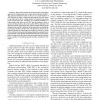87 search results - page 3 / 18 » Using hashing to solve the dictionary problem |
FOCS
2007
IEEE
13 years 11 months ago
2007
IEEE
We present a strongly history independent (SHI) hash table that supports search in O(1) worst-case time, and insert and delete in O(1) expected time using O(n) data space. This ma...
IJON
2002
13 years 5 months ago
2002
It was discovered recently that sparse decomposition by signal dictionaries results in dramatic improvement of the qualities of blind source separation. We exploit sparse decompos...
VTS
2003
IEEE
13 years 10 months ago
2003
IEEE
—We present a dictionary-based test data compression approach for reducing test data volume and testing time in SOCs. The proposed method is based on the use of a small number of...
PAMI
2012
11 years 7 months ago
2012
—Modeling data with linear combinations of a few elements from a learned dictionary has been the focus of much recent research in machine learning, neuroscience, and signal proce...
PKDD
2004
Springer
13 years 10 months ago
2004
Springer
The problem of discovering frequent subgraphs of graph data can be solved by constructing a candidate set of subgraphs first, and then, identifying within this candidate set those...

